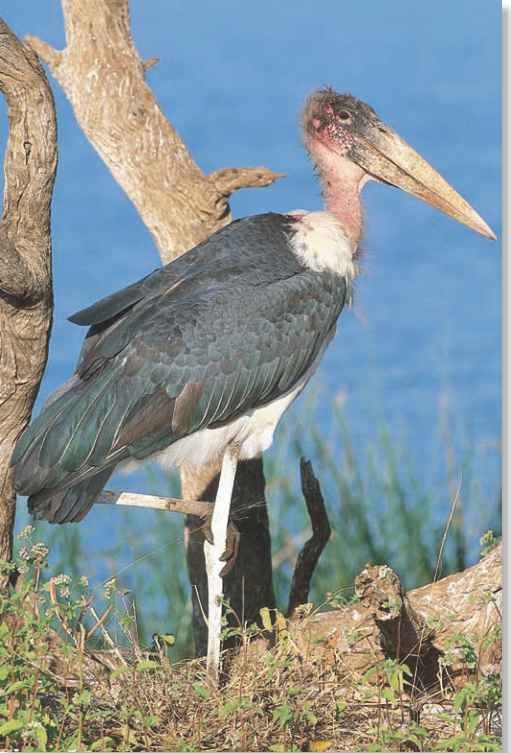ORDER
Ciconiiformes
FAMILY
Coniidae
GENUS & SPECIES
KEY FEATURES
• Signals dominance by inflating a gular pouch, which hangs down from the neck .
• Soars effortlessly using thermals to rise high in the air
• Constructs a huge nest that balances high in the treetops
• Devours almost any animal matter, dead or alive, including carrion scraps, fish and even crocodiles and birds
WHERE IN THE WORLD?
Found in many parts of tropical Africa; from Senegal east to Ethiopia and Somalia; south through Botswana and northeastern Namibia, down to South Africa

Lifecycle
Adapted for wading, the large marabou stork also roosts and nests comfortably on branches 120′ high and uses thermal soaring to fly effortlessly thousands of feet above the ground.
Habitat
Like all birds, the marabou stork’s choice of habitat is dependent upon the availability of food. Most marabou storks live in open country in arid or semiarid areas, but there is always a body of water within its flying range. The marabou hunts for fish and aquatic insects in large lakes, rivers and even small ponds. It also feeds on carrion, and for this reason, can be found scavenging near vulture attacks. With their wide variety of refuse, slaughter houses and garbage dumps also attract the hungry marabou stork. Euphorbia, acacia and baobob trees are the favorite communal roosting and nesting sites of the stork.
Made to wade The marabou stork’s long legs and partly webbed feet are well suited for wading in shallow water across its tropical African range.
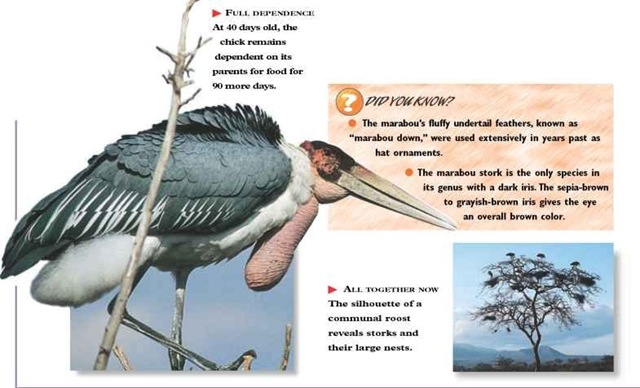
Breeding
The finished nest of a pair of marabou storks is impressive, measuring 3′ in diameter and 1′ thick. First, a 6-7 year old male selects a site, 6-1 20′ high in a tree and waits for a courting female. She must persistently perform submissive displays because the male rebuffs both males and females approaching his territory Once a pair is established, the male collects coarse sticks for their platform nest, which is built almost entirely by the female. She lays 2-3 eggs and both parents share incubation duties. After about 30 days, the eggs hatch at 1-3 day intervals. The hatchlings are pink and wrinkly Both parents feed fish to the young by regurgitating food onto the floor of the nest.
Food & feeding
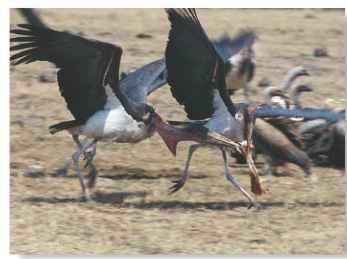
From tiny termites to colossal carrion pieces, the marabou stork eats essentially any animal matter, including baby birds. But fish and insects provide the bulk of the marabou’s diet. While wading in shallow water, the marabou stork immerses its slightly opened bill, snapping it shut when it comes in contact with prey. The bird also spreads its wings slightly, luring fish into the shade, then stabbing them with its sharp bill. The marabou also consumes frogs, rodents and even young crocodiles, but it won’t pass up the plant matter found among all the animal scraps in the garbage dumps it frequents.
flamingo feast
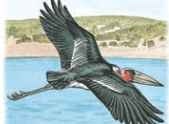
In the air…
Using warm thermals for lift, the marabou stork soars high above Lake Magadi, searching for food.
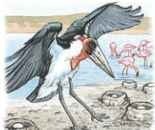
Waft to wall…
Spotting a breeding colony of lesser flamingos with many unattended nests, the marabou descends rapidly.
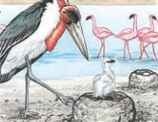
Panic attack…
A frightened chick attempts to stand in its unguarded nest, while nervous adults watch, waiting for the inevitable.
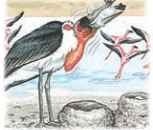
Fair and square
With no parent to attempt a defense, the chick is snatched by the marabou stork, and the adult flamingos flee the scene.
Behavior
A large bird, the marabou also gathers in large numbers at communal roosts containing up to a thousand other storks. The marabou is normally silent, since its voice box has no muscles, but it does emit grunts and squeals while roosting. Perching high in the tree, it has a perfect takeoff site for its early morning flights to feeding grounds.The marabou stork uses one of the most energy-efficient ways of flying:thermal soaring.Thermals are accumulations of the early morning heat that rise, often becoming visible as tufts of cloud, which the bird easily identifies.The stork uses the rising air to ascend, then glides to the base of the next thermal. It often soars thousands of feet high, and it can be almost invisible from the ground. But it is easily distinguished from other birds in flight; its long legs are held slightly away from the body and trail behind the bird.
Inflate to dominate The stork inflates its gular pouch as a sign of dominance and territoriality.
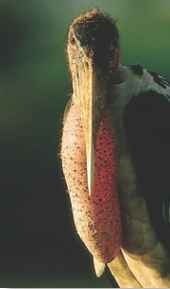
Conservation
Marabou stork populations in Africa are stable. They are often tame and may be kept as pets. The marabou stork is increasing in numbers in some parts of its African range, since it appears to benefit greatly from its exploitation of urban areas with their plentiful supply of refuse.The birds now rely on garbage dumps and other sites of accumulated waste for scavenging.
PROFILE
Marabou Stork
The marabou stork is a large bird but has almost no voice; its most formidable features are its inflated gular pouch and large pointed bill.
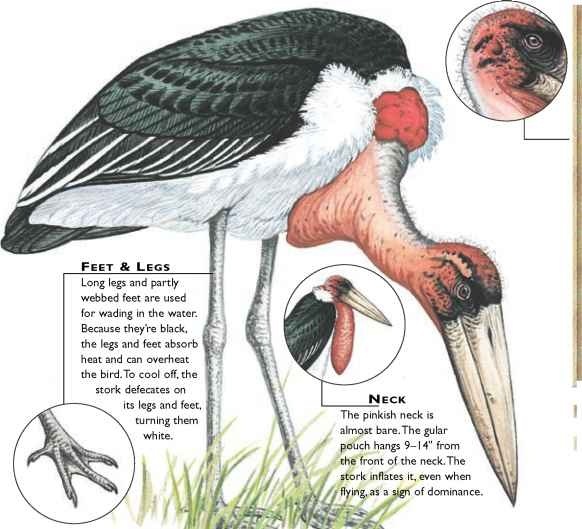
Creature comparisons
The marabou lives in Africa, while the greater adjutant stork (Leptoptilos dubius) lives in Asia. Habitat aside, the two birds are very similar: The greater adjutant is slate gray above, white below, much like the marabou’s dark slate-gray upperparts and white underparts. Both storks stand approximately 4′ tall, though the greater adjutant can grow up to 5′. A distinct feature of the marabou is its ladderlike band of white on the upper surface of the wing.This is only a single pale band of gray in the Greater adjutant stork greater adjutant.


Marabou stork
| VITAL Weight |
STATISTICS Up to 20 lbs. |
| Length | About 4′ |
| Wingspan | 7-9′ |
| Sexual Maturity | 4-7 years |
| Breeding Season | Varies according to region |
| Number of Eggs | 1-4, usually 2-3 |
| Incubation Period | 29-31 days |
| Fledging Period | 91-115 days |
| Breeding Interval | 1 year |
| Typical Diet | Carrion, fish, insects, birds, crocodile eggs |
| Lifespan | More than 41 years in captivity |
RELATED SPECIES
• The order Ciconiiformes includes ibises, spoon-I bills and herons, as well as storks. All are wading birds, and they have three characteristics in common: long legs, long necks and large, usually pointed, bills. These features are ideally designed for capturing fish and insects while wading in shallow water. The jabiru, Jabiru mycteria, is the largest stork in the Americas.
